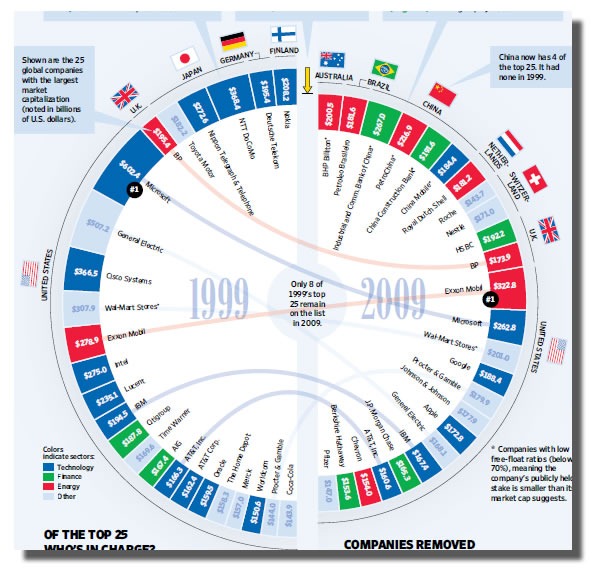As the decade draws to a close, you’re likely to see more and more articles and charts with a “decade in review” theme. Since technology is both my passion and the way I pay the rent, as well as an amorphous, unpredictable beast, I make note of those that look at changes in the field.
One that caught my eye is this chart from the Wall Street Journal comparing the top companies in 1999 against the top companies of 2009 (click it to see the full size version, a 500K PDF):

Tech companies made the majority of the top 25 in 1999; in 2009, energy and finance companies were the leaders. Other changes that took place over the decade include:
- Only 8 of the top 25 companies in 1999 were in the top 25 in 2009:
|
Tech companies (shown in dark blue) that were in the top 25 in 1999 (left side of the chart):
- AT&T Corp.
- AT&T Inc.
- Cisco
- Deutsche Telekom
- IBM
- Intel
- Lucent
- Microsoft
- Nippon Telegraph and Telephone
- Nokia
- NTT DoCoMo
- Oracle
- Worldcom
|
Tech companies (shown in dark blue) that were in the top 25 in 2009 (right side of the chart):
- Apple
- AT&T Inc.
- China Mobile
- Google
- IBM
- Microsoft
Companies that were also in the top 25 in 1999 are shown in bold italic.
|
- The total market cap of the top 25 in 2009 is 20% less than the total market cap of the top 25 in 1999.
- There were no Chinese companies in the top 25 in 1999; there are 4 in 2009.
- In 1999, there were 6 CEOs under 55 in the top 25; in 2009, there are 13.
- In 1999, there were 7 CEOs in the top 25 who were not American, in 2009, there are 11.
- In both 1999 and 2009, all the CEOs in the top 25 are men.
NYU professor William Easterly, in his article at the Aidwatch blog, writes that the changes between 1999 and 2009 suggest that this is more evidence of consumerization and that the “consumer” is king (I don’t like the term but can’t find a satisfactory substitute; I agree with Jerry Michalski – it makes us sound like “living gullets whose only purpose is to gulp down products and crap out cash). “The consumer,” he writes, “wants iPhones in their Xmas stocking and not whatever Worldcom had been pretending to be producing.”
The bringing of technology to consumer markets before business markets means a number of things:
- The generation known as "millennials," who are entering the workplace, are more likely to use the apps, devices and technology they like, and not those recommended or mandated by their company. This means that user experience is more important than ever. While company diktat once determined the technology that people used, the ready availability of technology and the democratization of the workplace has given more power to the individual.
- The ubiquitous connectivity that drives consumerization means suggests that the web, web services and web-based interfaces will become more prevalent. It also means that the time of the disconnected application is drawing to a close, or as I like to say, “No app is an island”.
- In some ways, it’s the 1980s all over again: a mish-mash of various types of technologies, many brought in the back door by employees (in the beginning, PCs at the workplace were brought in by early-adopter employees), which means that interoperability will provide many challenges – and opportunities.
- The technology mix – and the ownership mix – means that security will also be a challenge.
It’s food for thought as you make your personal and career tech plans for 2010.
This article also appears in Canadian Developer Connection.

 It’s another “local guy makes good” story:
It’s another “local guy makes good” story: 
